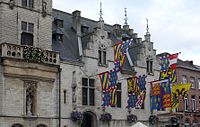
Back Portaal:Vlae en wapens Afrikaans بوابة:علم الشعارات Arabic Portal:Wappen German Portal:Heráldica y vexilología Spanish Portail:Héraldique French פורטל:דגלים וסמלים HE Portál:Heraldika Hungarian Portale:Araldica Italian Портал:Геральдика Kazakh Портал:Хералдика Macedonian
Welcome to the Heraldry and Vexillology Portal!


Heraldry encompasses all of the duties of a herald, including the science and art of designing, displaying, describing and recording coats of arms and badges, as well as the formal ceremonies and laws that regulate the use and inheritance of arms. The origins of heraldry lie in the medieval need to distinguish participants in battles or jousts, whose faces were hidden by steel helmets.
Vexillology (from the Latin vexillum, a flag or banner) is the scholarly study of flags, including the creation and development of a body of knowledge about flags of all types, their forms and functions, and of scientific theories and principles based on that knowledge. Flags were originally used to assist military coordination on the battlefield, and have evolved into a general tool for signalling and identification, particularly identification of countries.
Selected biography
Sir Alexander Colin Cole, KCB, KCVO, (16 May 1922–20 February 2001) was a long serving officer of arms at the College of Arms in London. He eventually rose to the rank of Garter Principal King of Arms, the highest heraldic office in England. Prior to his joining the College of Arms he represented the Manchester Palace of Varieties in the Court of Chivalry for the only case it has tried in the last 200 years. He designed the coat of arms for Margaret Thatcher. (more...)
Selected coat of arms

There are 26 modern cantons of Switzerland, each of which has an official flag and coat of arms.The history of development of these designs spans the 13th to 20th centuries. With the exception of Lucerne, Schwyz and Ticino, the cantonal coats of arms are simply arrangements of the cantonal flags in a shield shape. This fashion originates in the 15th century. (more...)
Selected flag

Throughout most of the history of Poland, the banner of Poland was one of the main symbols of the Polish State, normally reserved for use by the head of state. Although its design changed with time, it was generally a heraldic banner, i.e., one based directly on the national coat of arms: a crowned White Eagle on a red field (Gules an eagle Argent crowned Or). A national banner is not mentioned in the current (2007) regulations on Polish national symbols, although today's presidential jack is based directly on the pre-war design for the Banner of the Republic. (more...)
Selected picture

The town hall of Dendermonde, a city in Flanders, displaying heraldic banners.
Did you know...
- ...that during the Indonesian National Revolution the first Indonesian flag, Bendera Pusaka (first hoisting pictured), was cut in half to save it from the Dutch military forces?
- ...that Indonesia's first flag flown was fashioned by its first first lady Fatmawati?
- ...that in 1817, the previously banned coat of arms of Paris was restored to its traditional form?
- ...that the current flag of Bhutan was introduced after it was noticed the previous square version didn't flutter like the flag of India?
- ...that for the filming of Max Manus in 2008, the flag of Nazi Germany was flown from the roof of the Norwegian parliament building for the first time in over 60 years?
Related portals
|
|
|
Heraldry Web resources
Authorities
- Belgium - The Council of Nobility, Flemish Heraldic Council and Council of Heraldry and Vexillology of the French Community
- Canada - Canadian Heraldic Authority and see also Public Register of Arms, Flags and Badges
- England, Wales, and Northern Ireland - The College of Arms
- Ireland - The Office of the Chief Herald of Ireland
- Netherlands - High Council of Nobility
- Portugal - Instituto da Nobreza Portuguesa
- Scotland - The Court of the Lord Lyon
- South Africa - South African Bureau of Heraldry
- Sweden - National Board of Heraldry, The National Archive
- United States Army - The United States Army Institute of Heraldry
Societies
- Greek Heraldry Society
- The Academy of Heraldic Science Czech republic
- The American College of Heraldry
- The American Heraldry Society
- The Augustan Society
- The Australian Heraldry Society Inc.
- Bulgarian Heraldry and Vexillology Society
- The Center for Research of Orthodox Monarchism
- Cambridge University Heraldic and Genealogical Society
- Chiltern Heraldry Group
- The College of Dracology
- Croatian Heraldic and Vexillologic Association
- The Finnish Heraldic Society
- Fryske Rie foar Heraldyk
- Hellenic Armigers Society
- Guild of Heraldic Artists
- Genealogical Society of Ireland
- Heraldry Research Institute (Japan)
- The Heraldry Society
- The Heraldry Society of Africa
- The Heraldry Society of New Zealand Inc.
- The Heraldry Society of Scotland
- The Heraldry Society of Southern Africa
- The Institute of Heraldic and Genealogical Studies
- The International Association of Amateur Heralds
- Italian Center of Vexillological Studies
- Lancashire Heraldry Group
- Macedonian Heraldry Society
- New England Historic Genealogical Society Committee on Heraldry
- Norwegian Heraldry Society
- Oxford University Heraldry Society
- Polish Heraldry Society
- Polish Nobility Confederation
- Real Academia Matritense de Heráldica y Genealogía - Royal Academy of Heraldry and Genealogy of Madrid
- Romanian Institute for Genealogy and Heraldry
- The Royal Heraldry Society of Canada
- The Russian College of HeraldryThe Russian College of Heraldry
- Serbian Heraldic Society
- Societas Heraldica Scandinavica
- Societas Heraldica Slovenica
- Swedish Heraldic Society
- Ukrainian Heraldry Society
- Royal Association Genealogical and Heraldic Office of Belgium
Vexillology
Software
- Coat of Arms Visual Designer web-based program
- Puncher Heraldry Program
- Blazonry Server - pyBlazon
- DrawShield - creates SVG shield or arms image from blazon
- CoaMaker - web-based tool
- Blazon95 and BLAZONS! 2000, older Windows applications
- Heraldicon
Texts
- Heraldry, historical and popular : with seven hundred illustrations (1863)
- A Complete Guide to Heraldry (1909)
Other
Wikimedia
The following Wikimedia Foundation sister projects provide more on this subject:
-
Commons
Free media repository -
Wikibooks
Free textbooks and manuals -
Wikidata
Free knowledge base -
Wikinews
Free-content news -
Wikiquote
Collection of quotations -
Wikisource
Free-content library -
Wikispecies
Directory of species -
Wikiversity
Free learning tools -
Wikivoyage
Free travel guide -
Wiktionary
Dictionary and thesaurus
© MMXXIII Rich X Search. We shall prevail. All rights reserved. Rich X Search











